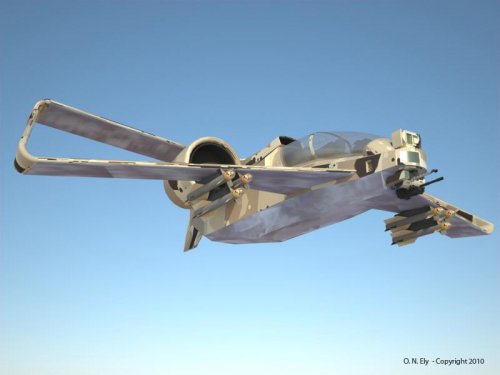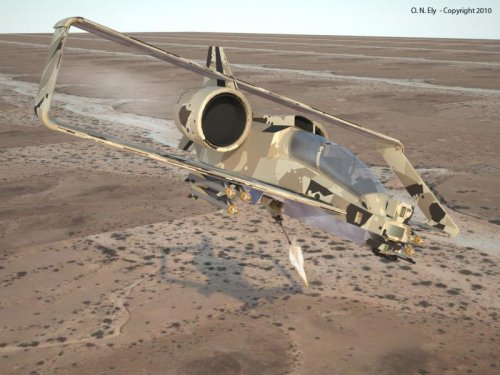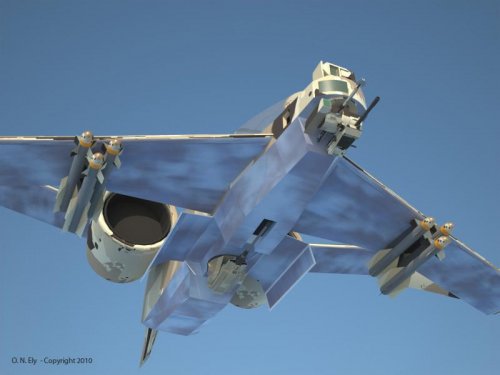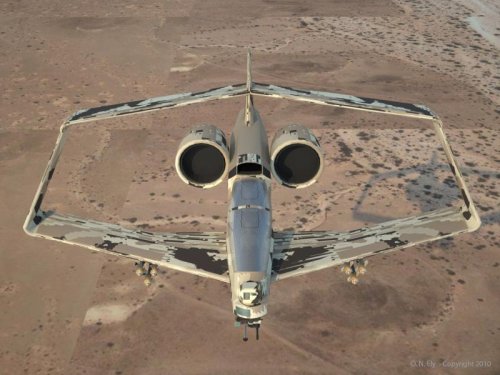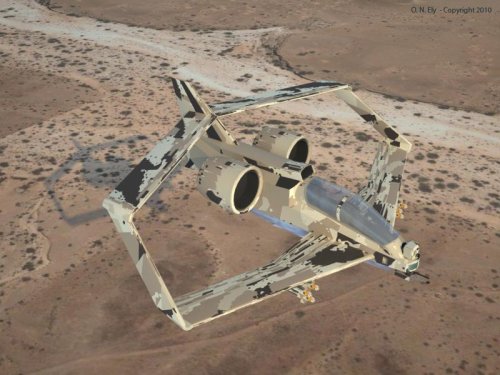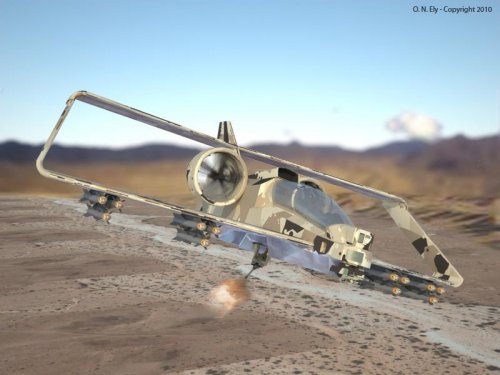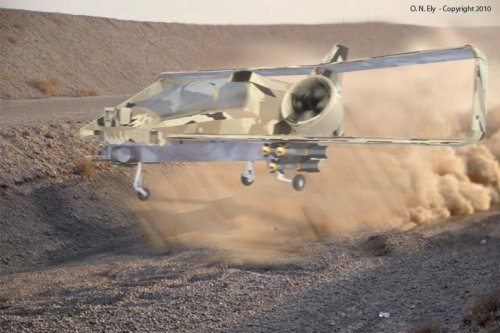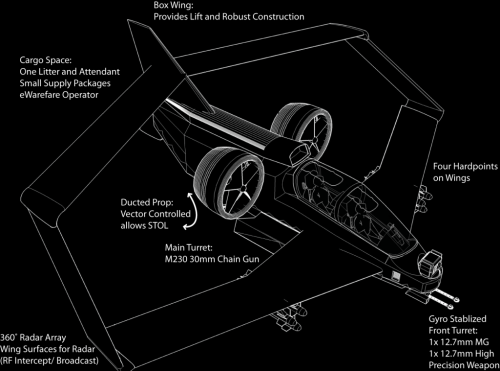- Joined
- 25 June 2009
- Messages
- 13,751
- Reaction score
- 2,943
Although the following project is extremely close in configuration to the Ikelos, a design by Virginia Polytechnic Institute & State University, Loughborough University (UK) (which placed second in a NASA Student Competition winning design from 2002), it is « a project that got “knocked out” in a weekend » according to its creator O. N. Ely. He explains that he "came across" the Ikelos in the course of his own project. « This was encouraging as the design was quite similar: In fact I shortened the ducts after [their] project (...) Their wing design is much better than mine. »
Source: http://www.architectswanderlust.com/2010/03/the-arbalest-close-air-support-cascoin-vstol-aircraft/
The DoD has been looking for Aircraft for Irregular Warfare of late: “U.S. Needs Stealthy Airlifter” (link), and last year the DoD was also been looking for a “COIN / CAS aircraft” (link). There is a clear gap in the market between traditional fighter, support planes designed for maneuver warfare, and the emerging tech around irregular warfare. One might call the new platform an armed “bush plane”. It is an interesting question: it is in some way to define a general class of aircraft that sits between helicopters and typical aircraft. This is a study that makes an attempt to take a fresh look at this paradigms.
Low cost COIN / LAAR Aircraft are being bought by many Nations. Typical of these aircraft is the Embraer EMB 314. This is a beautiful plane designed in Brazil. Without casting aspersions these aircraft, they function within a similar design paradigm as a P-51 Mustang. In fact in many cases they resemble the Mustang. These aircraft are multi-role fighters pressed into the role of Combat Air Support (CAS).
The Arbalest concept has “Very Short Takeoff and Landing” (VSTOL), it can tote a lot of fire power, or hang in the air for hours. The Arbalest sits between a A-10 Thunderbolt II (aka. The Warthog), an AH-64 Apache and a MQ-9 Reaper UAV. (Everything is “off the shelf” or under development, except the airframe.) This concept attempts to represent clear thinking about set of problems represented by the DoD’s LAAR solicitation, “A Clear Design Brief” if you like.
Is the reuse of a P51 Mustang is really the best solution for contemporary COIN / CAS / LAAR platforms?
The Arbalest : Takes its name from the steel crossbow that resembles the form the the airframe when bent. The steel crossbow was a contributor to the end of the age of Armor. It allowed untrained archers hiding behind walls to effectively pierce the armor of mounted knights. It was an inexpensive solution to a long standing problem. The Arbalest is a single engine, light combat aircraft is designed for patrols, fire support, e-warfare and observation. Any such aircraft should be field deploy-able and have STOL capabilities. It should fall between an Apache, an A10 and a Reaper in capacities. Yet it should cost much less.
What is needed is a tight design brief for a contemporary CAS / COIN / Observation platform: An idea started to form that this plane would be stationed directly with forward units, (like a helicopter) providing trusted and immediate air support. However, the long loiter time and ability to fly at altitude provides real gains for Combat Air Support.
This resulted in a design using a “Box Wing” and “Ducted Fan” propulsion: The “box wing” allows the use of narrow wing cross section creating lower drag and greater wing area in a smaller footprint. The “Ducted Fan” creates more thrust than a conventional propeller and quiets the noise of the prop. Further the ducts allow the thrust to be “Vectored” to create additional lift. Combined with the low stall speed and tight turning radius (due to many vertical surfaces and short wing span) this plane can loiter over head and provide precise fire support to troops on the ground.
- Fuel Efficient
- Inexpensive
- Survivable: Armor for Crew and Engines
- Easy to Fly – or Learn to Fly
- Low Stall Speed
- Long loiter time
- E-Warfare / Observation / Survey
- All Weather – Night Vision
- Known Technologies
- Precise Firepower
- Suitable for forward deployment
- VSTOL (Very Short Take Off and Landing)
- Rough Runways
The Arbalest can be stationed close to combat areas and take off quickly on improvised run ways due to its large wing area and ducted propellers. Further, the box wing creates a form that is self bracing allowing a stronger air frame than conventional designs. The design shown here is intentioned as “overbuilt” to withstand decades of deployment. (Note the “fat ass” and chunky construction in the illustration “Project Characteristics”.)
This airframe can function in multiple roles. With a similar wing area as a Reaper it could fly high and observe the goings on of the world. However, the low stall speed allows it to support ground troops and fly Nap of the Earth. “Slow and Low” if you like. The Arbalest’s draw back is that it will never be as fast as an open prop plane or jet. This platform will never be a great air-to-air fighter. It is designed for permissive environments.
Very Short Take-Off and Landing (VSTOL):
The Arbalest is designed to be Very Short Take Off and Landing (vSTOL). The ducted props should “sit” near the center of lift/gravity. That is to say between the wings so they can “vector with thrust” and increase lift. The wings needs some forward speed to provide the lift and come into play, that means VTOL will not work here. Not making it Vertical Take Off and Landing (VTOL) was a design compromise.
Armaments:
This platform is designed to provide precise fire support to ground troops. The “Main Turret” allows it to engage enemy forces with more precise fire than conventional wing mounted arms. To further the increase the accuracy of the platform the “Front Turret” has two gyro stabilized mounts that allow marksmenship like percision at range. A system such as Sagetech’s TAPSS system could be used. (link to pdf). With a range of 1500m this allows single individuals to be targeted with much lower risk of collateral damage. There is an emphasis on firearms rather than guided munitions with a view toward operational cost. Bullets are simply less expensive than missiles.
That said with the heavy Arbalest is capable of carrying a full complement of guided or unguided munitions mounted on it’s five hard-points.
Cargo Area:
A small cargo area has been placed in the back of the plane. This will be about 3.5m3 (125 cu ft.). It is large enough for a stretcher and attendant, Various packages would be possible: a radio operator / eWarefare Officer / life raft or supplies. It will be accessed by a back hatch of 1000mm x 1500mm. This is still being worked into the design and is not reflected in the illustration here.
If it is possible to land the Arbalest in 50m (150ft) then it would be possible land on the deck of a Destroyer. That short seems unlikely as the Arbalest is heavier than the Ikelos. However, with a bit of assistance it might be possible. It would certainly be suitable for Helicopter Carriers, Amphibious Assault Ship, or Queen Elizabeth class aircraft carrier. The VSTOL capacity of the Arbalest could be very useful in a Navel role. Combined with Harrier or F-35B STOVL, for air support / protection, the Arbalest could provide new fire power and endurance in naval roles. The Navy likes twin engine aircraft. Yet another design revision? I am going to guess that might take a bit more effort.
Projected Characteristics:
- Crew: 2
- Length: 9.5m
- Wingspan: 11.5m
- Height: 3.6m
- Wing area: 28m2
- Dry Empty weight: 1200 kg
- Power-plant: Turboprop (PT6A-68A or similar)
Performance
Armament
- Maximum speed: 380 Kts
- Cruise Speed: 280 Kts
- Range: to 700nm, (1200nm @ 180kts) Greater with fuel pods.
- Service ceiling: 15,000m
- Stall Speed: 40Knots
- Loiter Time: 8 hours +
- Liftoff and Landing in less than 50m
- Take off to 17m altitude in less than 100m
- Guns:
- Front “Noise” Turret (270 degree traverse):Two mounts Gyro Stabilized (link) auto “precision“ weapon system: 12.7mm, 8.58 mm, 7.62mm, and 5.56mm Machine Guns, 40mm Grenade Launcher
- Lower “Belly” Turret (360 degree traverse): M230 Chain Gun (30mm), M197 Vulcan (20mm), M139 Mine Dispensing System, Station for Stores of other Munitions or Fuel
- Total stores stations 5: 1 Internal “Belly Turret”, and 4 under wing.
- Bombs: Bombs up to 500 lb (227 kg)
- Rockets: Hydra 70 rockets, other
- 2.75” rockets (FFARs), including the guided versions such as APKWS
- Missiles: AIM-92 Stinger / AIM-9 Sidewinder (Wing pylons only), Hellfire AGM-114, PARS 3 LR, Other?
- GBU-39 250lb Small Diameter Bombs
Source: http://www.architectswanderlust.com/2010/03/the-arbalest-close-air-support-cascoin-vstol-aircraft/
Attachments
Last edited by a moderator:

